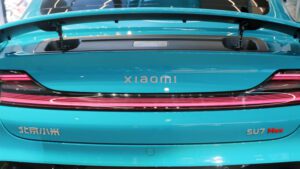Toyota's Going All In On Hydrogen Fuel-Cell Trucks In Kentucky

Good morning! It’s Tuesday, July 11, 2023 and this is The Morning Shift, your daily roundup of the top automotive headlines from around the world, in one place. Here are the important stories you need to know.
Jalopinions | The Best Type is Jaguar’s E-Type
1st Gear: Toyota’s Hydrogen Future
This December, Toyota expects to begin building hydrogen drivetrains in the U.S., specifically in Kentucky. The drivetrains will be built specifically for heavy-duty commercial trucks to start, though eventually Toyota expects to make them at the Georgetown facility for passenger cars as well. From Automotive News:
Mitsumasa Yamagata, president of the Hydrogen Factory, said tapping into trucking will help Toyota reach fuel cell volumes as high as 200,000 commercial and passenger vehicles in 2030.
Toyota says it has business offers to support volume of 100,000 fuel cell systems in 2030, with heavy duty trucks accounting for about 35 percent of the total.
But executives forecast they can reach 200,000 thanks to newly forged partnerships with truckmaking companies. In May, for instance, Toyota agreed with Daimler Truck Holding AG to merge Toyota’s Hino truckmaking subsidiary with Daimler’s Mitsubishi Fuso truck unit.
Rolling out hydrogen-powered trucks is one of the that new venture’s focal points.
Toyota needs to reach production volumes of at least 10,000 units a month in order for hydrogen fuel cell production to break even, Toyota Chief Technology Officer Hiroki Nakajima said. And volume can be reached only after driving down the cost of the technology, which relies on precious metals, precision manufacturing and expensive carbon fiber-wrapped tanks.
“First we need to reduce the price, then we can increase the volume,” Nakajima said Tuesday at a briefing on the technology. “Once we hit a tipping point, there will be explosive expansion.”
For now, Toyota hasn’t placed a projection on the number of fuel cell systems it expects to build on a regular basis in Kentucky, nor when it predicts it’ll achieve 10,000-unit-per-month production. But commercial trucking seems to be the safest avenue for such tech at the moment, because it carries a heavy, reliable investment per vehicle:
Because trucks run on established routes, over and over, they can guarantee consistent early business for costly hydrogen stations. Trucks make it possible to sell a lot of hydrogen in one place. And this creates a baked-in network to support passenger cars when they come to market.
Also, refueling time for hydrogen is about the same as for diesel, avoiding the long waits needed to recharge an electric battery in full-electric trucks. Finally, the energy density of hydrogen allows for driving ranges on par with today’s internal combustion-powered trucks.
As such, the technology these rigs will be using isn’t all too different from what’s inside Toyota’s Mirai sedan you see at the top of this page — it’s just amplified, to offer 160 kilowatts of power versus the Mirai’s 128. The resulting trucks will be able to haul 80,000-pound loads for distances up to 300 miles, according to the company.
Toyota’s next hydrogen system due in 2026 is targeting a 50 percent cost reduction to the fuel stack, a quarter reduction in the price of the tank and 20-percent improved cruising range. It’ll also be more modular, so it can fit into a wider breadth of vehicles. But whether or not we’ll get used to seeing it on our roads depends on whether the automaker can hit its break-even number and reach that “explosive expansion” it envisions. For now, the only passenger hydrogen fuel cell car it’ll continue to offer to customers for the foreseeable future is the Mirai.
2nd Gear: Rivian’s Shares Rose 48 Percent Last Week
Rivian’s second-quarter results were very impressive and certainly allowed the startup to breathe a huge sigh of relief. They also sent share prices up — way up, by half, per Bloomberg. The business news agency had a chat with CEO RJ Scaringe last week to offer a little background behind recent triumphs and the future:
“Given that the supply chain confidence is there, and given that our operational experience is so much stronger, we’re able to have a level of predictability to the business that, in the first 12 months, we really didn’t have,” Scaringe said in an interview last week with Bloomberg TV.
Scaringe also said that the company’s forthcoming R2 range and platform will help qualify some of its vehicles for tax credits:
On R2, the entirety of the program has been set up to make sure that it’s IRA compliant. So the sourcing of battery cells, where they’re produced, how the packs come together — all will be in the US.
The vehicle needs to be IRA-compliant, because that $7,500 customer-facing credit is really important in a vehicle at this price point. The price range in R2 will range from roughly $40,000 to $60,000. It’s really important that that $7,500 credit is built into that price.
It’s also equalizing production of the R1T pickup and R1S SUV:
The first vehicle when we started production was the R1T, and up through the end of the first quarter of this year, roughly 75% of our production was R1T. The demand mix was roughly 75% R1S, so we were producing a disproportionately large number of R1Ts relative to demand.
We’re now getting that to a point where production matches demand. For the next few quarters, we’re going to try to catch up a little bit on R1S.
And getting better support from its suppliers, thanks to what sounds like a locker room pep talk from a college sports movie:
Late last year, we brought all our suppliers to the plant for a day. […] We had hundreds of our suppliers there — senior leaders, CEOs, senior executives — and I said, I want every one of you to look to your left and look to your right, and recognize that the volume that you’re going to get from us is based on how effective all of you collectively are at delivering on our asks.
Whatever Rivian’s doing, it’s finally working (this week, according to the stock price).
3rd Gear: Volkswagen Faces More Xinjiang Questions
A group of shareholders asked Volkswagen a very fair question this week: How can it be sure that a scheduled audit of its Xinjiang facility, where the company has denied using forced Uyghur labor, will be truly independent given the government’s pressure? From Reuters:
Volkswagen was challenged by an investor association on Tuesday about the planned audit of its co-owned site in Xinjiang, China, adding to concerns raised by human rights activists that the measure would be ineffective.
The Association of Critical Shareholders (DKA), which represents small investors on environmental, social and governance issues, asked Volkswagen in an open letter how it would ensure results were independent given China’s anti-espionage laws.
It highlighted restrictions imposed by the Chinese government on international auditors, including the raid of U.S. corporate auditor Mintz Group’s offices in Beijing and reports China instructed state-owned enterprises to stop using PwC, EY, KPMG and Deloitte.
“We therefore see a very high risk that the Chinese government will misuse the audit for its international disinformation campaign to conceal the actual conditions at the plant,” the DKA wrote.
Neither Volkswagen nor its Chinese manufacturing partner SAIC responded, which is about the way these things typically go. Aside from VW, BMW and Mercedes-Benz also deal with suppliers in the region, although they don’t operate facilities there themselves.
4th Gear: Nio’s In Trouble Again
The Chinese government effectively rescued Nio to the tune of a $1.4 billion bailout in 2020 which left the EV maker looking quite strong. Massive sums of cash have a way of doing that. But once again, the brand has found itself in a predicament. Its cars aren’t selling, the competition is beating it to the punch and it’s not pulling all that much of a profit on what it does manage to move. Courtesy Bloomberg:
While senior executives earlier claimed to be “very confident” of reaching a target to double sales to 250,000 electric vehicles this year, Nio only managed to deliver 54,561 cars in the first half — just over 20% of its annual goal. It also missed its annual target for 2022.
Nio founder and Chief Executive Officer William Li said during an analysts’ call last month that the company had been forced to delay investment in fixed assets, postpone some R&D plans and take a more cautious approach to overseas expansion. He was addressing the market after Nio reported a wider-than-estimated first-quarter loss of 4.74 billion yuan.
Gross margins for that period dropped to 1.5%. Nio has had to push back its break-even point, which is clearly worrying investors considering they’ve sent the company’s US-listed shares down almost 50% over the past 12 months.
Abu Dhabi recently took a 7 percent stake in Nio, which translated to a $738-million care package. But at the rate Nio’s burning through cash, that might not make much of a difference anymore. And with other players like BYD cementing themselves at the top of China’s auto market, Nio may no longer be able to count on saviors in high places.
Reverse: Skylab Down
On this day in 1979, 44 years ago…
Neutral: Pour One Out
Image: Honda
On the subject of hydrogen cars, I’m not saying the Honda Clarity Fuel Cell was a perfect vehicle or anything, but I will say that I was sold on it as soon as I saw the wheel spats. Those have to make a comeback.




